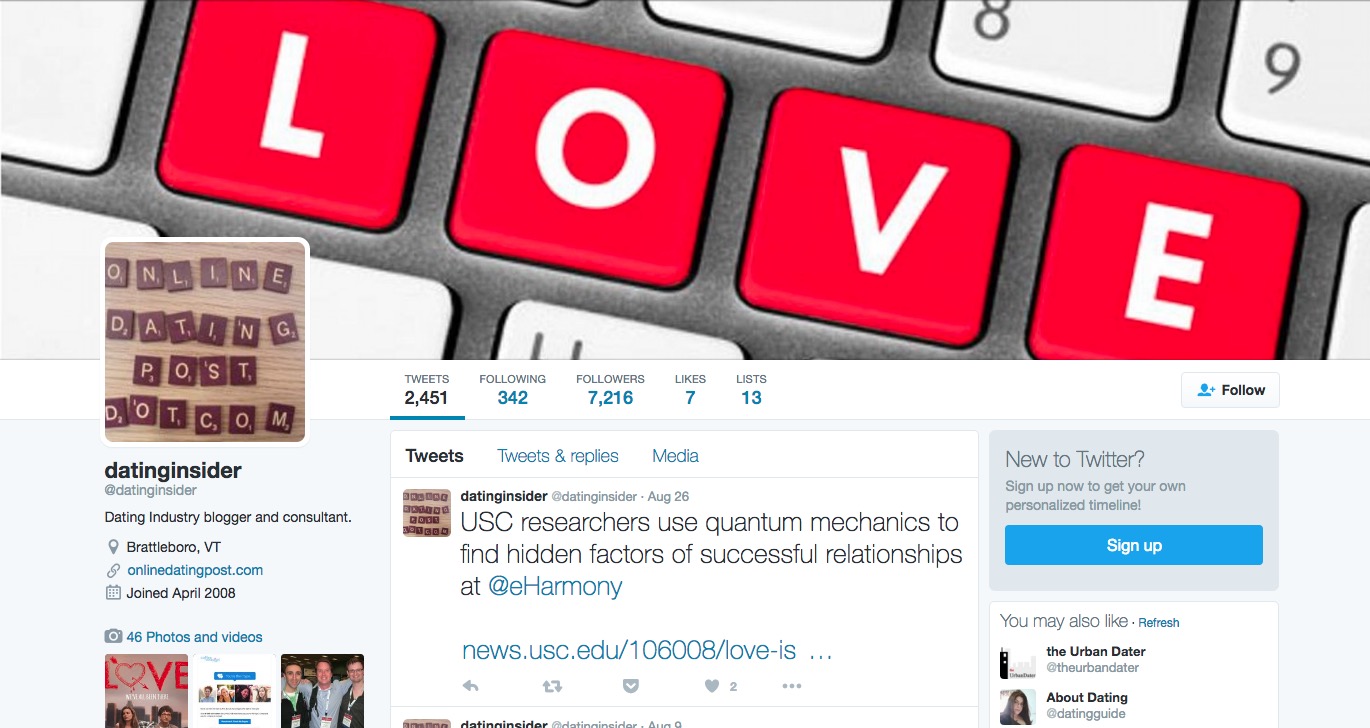Piers Steel at the University of Calgary was nice enough to respond to my request for more information about his mathematical formula called Synthetic Validity; A mathematical theory that attempts to bridge the gap between individuals’ personalities and abilities. Synthetic Validity, while being touted as the next big thing in Human Resources, may also be a good fit for the online dating industry.
I think pheromones are better for compatibility testing but what do I know?
Here’s what Mr. Steel has to say:
Originally designed for industry and their stricter requirements (e.g., able to withstand legal challenges), synthetic validity is a methodology to create a fully automatic selection system. By changing the metric from job performance to relationship satisfaction, you can use it to select romantic partners as well. In fact, it is much easier to use it for dating. It is simply putting “soul mate� selection on a firm measurement and scientific foundation, taking advantage of 100 years of selection research.
The methodology is complex in parts, and if you want to know how it works, you can download a copy directly.
However, be sure that it does work. The International Journal of Selection and Assessment, where it was published, is a peer-reviewed top management journal that specializes in this topic (see http://www.blackwellpublishing.com/journal.asp?ref=0965-075X). This is the sum of decades of effort and it starting to come under an increasingly amount of press:
Peter thinks the Globe and Mail article does the best at summarizing the process, so if you have trouble accessing it, here is a key paragraph:
The mathematics involved are complex, but the idea itself is devilishly simple. First, a particular job is broken down into a series of behaviours — common building blocks that could be assembled in different combinations to describe any kind of work. Coaching others, or a customer-service orientation are examples of such building blocks. Then, the predictors of those behaviours, from tests of individuals, are ascertained. The next, and most complicated step, is to establish the relationship between the two.
As it applies to dating, the methodology begins with breaking down relationship satisfaction into fundamental elements (e.g., physical, emotional, intellectual) that encompass the important parts of any relationship. The association between each of these elements and any predictor (pretty much anything you can quantify) is determined. To apply it to new candidate, they simply indicate what relationship elements are most important to them and how much. After that, the algorithms take over and provide your results.
What can it do?
1. To begin with, it can provide an overall ranking as well as break it down to specific relationship domains. In other words, it tells you who are overall the best as well what areas of the relationship they will likely excel at.
2. Because you have it overall as well as by life domains, there are a variety of measurement issues that come into play that improves your accuracy of prediction. For example, people can weight what life areas are most important to them (e.g., adventure, work, religion).
3. You can start to investigate generalizability, determining how many different life domains can be meaningfully separated (this will again help prediction).
4. To prevent user fatigue, you can use different sets of predictive tests. You can start with a brief selection system, provide increasingly complex assessment in stages, or use full-blown selection. You will able to predict at each stage.
5. You can select for short-term as well as long-term attraction and happiness. We ran into this problem in personnel selection a while ago. Some people were great out of the gate but slow in the stretch. The solution is time-varying covariates, but it requires gathering data at many stages of the relationship.
6. You can give confidence intervals around expected satisfaction at any time and how the relationship is expected to progress.
7. You can mathematically determine what set of predictors works the best.
You can also start moving beyond simply selection and provide advice.
1. You can point area of strength and “hot spots,� where tension is likely to arise.
2. You can suggest areas of personal improvement that will help people interest those they would be happy with.
Again, the choice of predictors is pretty much whatever you want; as long as the predictor is quantifiable, you can incorporate it in to the selection system. Consequently, it would make sense to develop a culture of constant improvement. Let different predictors compete against one another by constantly feeding the system new data (by the way, the new data is NOT simply responses on predictor tests alone). You still will retain backward compatibility. That is, later users will be even better matched but you can still provide services to those who have to yet to update their profiles.
It short, your dating system should be more accurate and provide richer feedback than anything else in the market and furthermore there are clear steps for constant improvement to maintain that advantage. If you want to explore using this methodology, contact Ian Bell at the Technological Transfer unit at the University of Calgary.
Update: Here’s a list of 10 more scientific papers about theories of romantic relationships development.
Technorati Tags: personality assessment, synthetic validity

